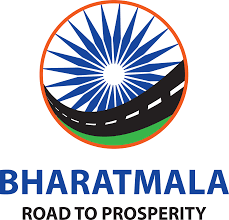This article needs to be updated.(September 2024) |
| Bharatmala | |
|---|---|
 | |
| Type of project | Infrastructure |
| Country | India |
| Prime Minister(s) | Narendra Modi |
| Ministry | Ministry of Road Transport and Highways |
| Key people | Nitin Gadkari |
| Established | 31 July 2015 |
| Status | Active |
| This article is part of a series on the |
| Politics of India |
|---|
 |
The Bharatmala Pariyojna (lit. 'India garland project') is a project in India implemented by Government of India. It is slated to interconnect 550 District Headquarters (from the current 300) through a minimum 4-lane highway by raising the number of corridors to 50 (from the current 6) and move 80% of freight traffic (40% currently) to National Highways by interconnecting 24 logistics parks, 66 inter-corridors (IC) of total 8,000 km (5,000 mi), 116 feeder routes (FR) of total 7,500 km (4,700 mi) and 7 northeast Multi-Modal waterway ports. [1] The project also includes the development of tunnels, bridges, elevated corridors, flyovers, overpasses, interchanges, bypasses, ring roads, etc. to provide the shortest, jam-free & optimized connectivity to multiple places, it is a centrally-sponsored and funded Road and Highways project of the Government of India. [2]
Contents
- Context
- Size of Indian highway network
- Benefits of Bharatmala
- Project components
- Components summary
- National Highways Development Project (NHDP)
- Economic Corridors
- Finance
- Central Road Fund (CRF)
- Bharatmala Phase-I funds
- Implementation phases
- NHIDCL
- Phases
- See also
- References
- External links
This ambitious umbrella programme subsumed all existing Highway Projects including the flagship National Highways Development Project (NHDP), launched by the Atal Bihari Vajpayee government in 1998. The total investment for 83,677 km (51,994 mi) [3] committed new highways is estimated at ₹10.63 trillion (US$130 billion), making it the single largest outlay for a government road construction scheme (as of March 2022). The project will build highways from Maharashtra, Gujarat, Rajasthan, Punjab, Haryana and then cover the entire string of Himalayan territories - Jammu and Kashmir, Himachal Pradesh, Uttarakhand - and then portions of borders of Uttar Pradesh and Bihar alongside Terai, and move to West Bengal, Sikkim, Assam, Arunachal Pradesh, and right up to the Indo-Myanmar border in Manipur and Mizoram. [2] Special emphasis will be given on providing connectivity to far-flung border and rural areas including the tribal and backward areas. [4]
Other than NHDP related projects which are greenfield, there is Brownfield National Highway Projects which is an upgrade/widening of existing 4-lane highways into 6-lane highways that are not controlled access highways. [5] Many state highways have been converted to National Highways under this project. [6] It is both enabler and beneficiary of other key Government of India schemes, such as Industrial corridor, Make in India, Startup India, Standup India, Setu Bharatam, Sagarmala, Dedicated Freight Corridors(DFC), UDAN-RCS, Digital India, BharatNet, Parvatmala.